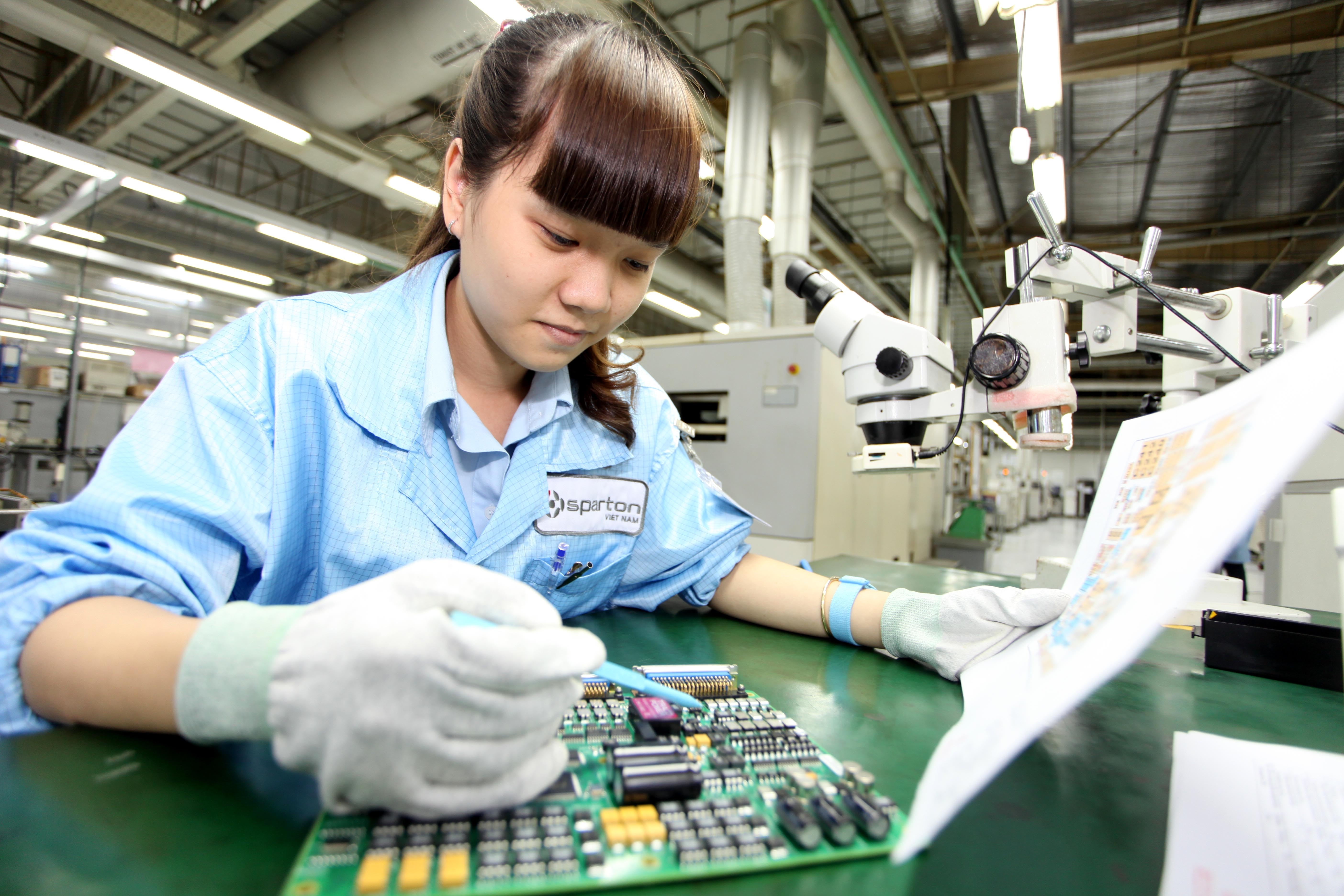Moody’s revises Vietnam outlook as “positive”

|
Vietnam’s ratings on Moody’s: Issuer and senior unsecured debt ratings: B1 (affirmed) Outlook: Positive (upgraded from: Stable) Local currency bond and deposit ceilings: Baa3 (upgraded from Ba1) Foreign currency bond ceiling: Ba2 (unchanged) Foreign currency deposit ceiling: B2 (unchanged) Short-term foreign currency bond and deposit ceilings: Not Prime (unchanged) Short-term foreign currency deposit ceiling: Not Prime (unchanged) |
Strong attraction, positive policies
Moody’s Investors Service reaffirmed Vietnam’s issuer and senior usecured ratings at B1, while professing to great optimism about a potential upgrade in the near future. According to the ratings agency, Vietnam is outperforming its B1-rated peers in a great number of macroeconomic indices, including sustained strong GDP growth and international trade activities, and its economic policies are on the right track, albeit there is certainly room for improvement.
Factors holding the country back are the low GDP per capita as well as vulnerabilities posed by wide fiscal deficits and the accumulation of debt over the past few years—which the ratings agency has expressed optimism about, saying policies to tackle the issue were underway and would likely prevent further increases.
Without finding significant cause for concern, Moody’s evaluation implies that Vietnam is right on track for a future upgrade in credit ratings.
Growth and FDI: running laps around the competition
Strong FDI inflows were rated as the first driver in Moody’s evaluation. Recognising the process of ongoing economic reform and liberalisation, the agency was certain the incoming robust foreign investments will diversify the economy and enhance economic performance compared to rating peers.
Moody’s acknowledged that Vietnam’s economic growth far outstrips its peers in the B1 bracket: it forecasted a 6.3 per cent growth rate through 2019 against the B1 rated median of 3.3 per cent.
This the agency explained by the country’s impressive FDI attraction performance. During the 2014-2016 period, Vietnam’s net FDI inflow averaged at 5.2 per cent of the GDP, higher than the B1 rated median of 3.6 per cent. This was partly due to the new free trade agreements Vietnam has signed and is negotiating, integrating it further into the world economy and giving it prospects of sustained GDP growth by enhancing the country’s market share in international trade.
Foreign trade, the lifeline of Vietnamese economy, has been flourishing in the last years: as FDI investments turn towards higher value-added production in the manufacturing sector (primarily mobile phones), the country’s export growth outperforms regional and rating peers by a significant margin. During 2013-2016, Vietnam has almost doubled its market share of world exports, growing from 0.7 per cent to 1.2 per cent.
Additionally, Moody’s has made specific mention of the improving investment climate, quoting improvements in Vietnam’s ranking in the World Economic Forum Global Competitiveness Index (60th in 2016-2017 from 70th in 2013-2014) and the World Bank’s Doing Business Indicators (82nd in 2017 from 99th in 2014). Keeping the onus on FDI development, the rating of the country’s investment climate is essential in the attraction of foreign capital.
Macroeconomic and external stability
The second driver of Moody’s appraisal was the macroeconomic and external stability Vietnam currently enjoys. The evaluation turned particularly optimistic regarding the moderate inflation and ample foreign exchange reserves, key to internal and external stability.
In contrast to the pre-2012 rapid growth that was accompanied by high inflation, wide current account deficits, and an overheating property market, Vietnam’s current growth pattern dictates moderate and restricted inflation. Primarily pushed by administrative price increases for health and education expenses, there has been healthy increase in the last three years, to reach 5 per cent in 2017. While Moody’s expects the rate to remain under the government target of 5 per cent by the end of the year, the developments of recent years have positive implications.
|
Moody’s on the benefits of moderate inflation in Vietnam: Moderate inflation supports consumer purchasing power and helps contain local currency borrowing costs for the government. The de-dollarisation trend in recent years and the concurrent deepening of local capital markets also foster moderate inflation by promoting relative stability of the exchange rate and much reduced reliance on an unofficial exchange rate.
|
Additionally, due to robust exports and steady remittance flows, Vietnam is looking back on six consecutive years of current account surpluses. Coupled with strong FDI inflows, this effectively shored up foreign exchange buffers that have been hanging low since 2011, promising more resilience to the economy.
In Moody’s reading, the adoption of a more flexible exchange rate regime in 2016, combined with the strengthened buffers will ensure that Vietnam’s foreign exchange reserves remain ample, meaning external vulnerability risk is very low.
Stabilising debt
According to Moody’s, both the robust growth and macroeconomic stability provide an ideal situation to stabilise the government’s debt burden. While the ratings agency expected government debts to have peaked at 55 per cent of the GDP in 2016, it has not identified sufficient efforts at revenue reform or expenditure consolidation to forecast a more rapid pace of debt reduction.
In the near term, Moody’s expects the robust domestic demand and international oil prices to boost state coffers, which will help deal with debts unless it is used to cut down on other revenue sources or is channelled into other purposes.
On the expenditure side, the government’s adjustments to spending on education and healthcare is expected to further benefit, not to mention the divestment initiative from SOEs, which Moody’s has discounted.
Additionally, Moody’s identified positive tendencies in the funding structure of government debt. Accordingly, the government is gradually increasing reliance on domestic and local currency sources of financing, which has reduced foreign currency-denominated debt. This ratio fell from 61 per cent in 2011 to 39.8 per cent in 2016, helping to reduce Vietnam’s susceptibility to exchange rate shocks.
Altogether, Moody’s has expressed optimism about Vietnam securing external surpluses to ensure liquidity, as well as its robust employment effecting deposit growth in the banking system. As long as the government can keep its balance sheet less exposed to external shocks, the ratings agency expects positive developments.
Set for an upgrade
While expressing optimism that if the current state of events remain unchanged, Vietnam’s credit rating will be upgraded, Moody’s outlined pitfalls that could negatively affect it. This includes a re-emergence of macroeconomic instability, leading to higher inflation and a rise in debt-servicing costs and destabilising the country’s external payments position. Alternatively, a significant weakening in economic performance that would push Vietnam under the B1 rated bracket, or a “crystallisation of contingent risks from either the banking system or the SOE sector” could also lead to downgrading.
In summary, Vietnam seems set for Moody’s to upgrade its credit rating given time, as only borderline catastrophe would shake the economy enough to divert it from its path.
What the stars mean:
★ Poor ★ ★ Promising ★★★ Good ★★★★ Very good ★★★★★ Exceptional
Latest News
More News
- Gold skyrockets on back of tariff barrage (April 09, 2025 | 09:18)
- World Bank to help SBV build shared database for banking industry (April 09, 2025 | 08:55)
- Exchange-traded funds appealing for digital assets (April 09, 2025 | 08:00)
- Vietnam to seek US tariff postponement to serve negotiations (April 08, 2025 | 16:09)
- Vietnam strives to alleviate US tariff plan (April 08, 2025 | 10:21)
- Dutch bank FMO grants $15 million to Phuc Sinh (April 07, 2025 | 10:15)
- Tariff shock poses resilience test for investors (April 05, 2025 | 10:00)
- Vietnam can leverage advantages to develop a financial centre (April 04, 2025 | 18:59)
- Crypto clarity could offer fresh investment channels (April 04, 2025 | 16:22)
- Pilot policy to set up digital asset tax framework (April 04, 2025 | 16:17)


















 Mobile Version
Mobile Version